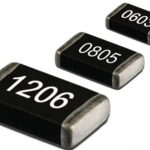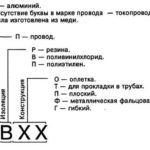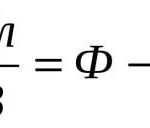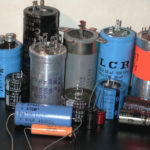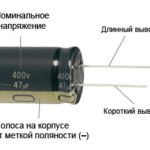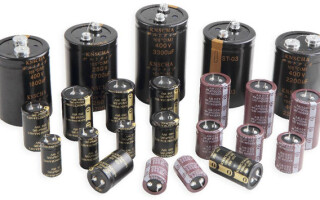Basic information about the characteristics of capacitors, which are components of almost all electronic circuits, is usually placed on their cases. Depending on the size of the element, the manufacturer, the time of production, the data applied to the electronic device is constantly changing not only in composition, but also in appearance.

With a decrease in the size of the case, the composition of alphanumeric designations changed, was coded, and was replaced by color marking. A variety of internal standards used by manufacturers of electronic components requires certain knowledge to correctly interpret the information printed on an electronic device.
Content
Why is labeling necessary?
The purpose of marking electronic components is to be able to accurately identify them. Capacitor markings include:
- data on the capacitance of the capacitor - the main characteristic of the element;
- information about the rated voltage at which the device retains its performance;
- data on the temperature coefficient of capacitance, which characterizes the process of changing the capacitance of the capacitor depending on the change in ambient temperature;
- the percentage of permissible deviation of the capacitance from the nominal value indicated on the body of the device;
- release date.
For capacitors that require polarity to be connected, information is required to correctly orient the element in the electronic circuit.

The marking system for capacitors produced at enterprises that were part of the USSR had fundamental differences from the marking system used at that time by foreign companies.
Marking of domestic capacitors
All post-Soviet enterprises are characterized by fairly complete labeling of radioelements, which allows minor differences in designations.
Capacity
The first and most important parameter of a capacitor is capacitance. In this regard, the value of this characteristic is in the first place and is encoded with an alphanumeric designation. Since the capacitance unit is a farad, the letter designation contains either the Cyrillic alphabet symbol “Ф” or the Latin alphabet symbol “F”.
Since the farad is a large value, and the elements used in industry have much lower denominations, the units of measurement have various diminutive prefixes (mili-, micro-, nano- and pico).The letters of the Greek alphabet are also used to designate them.
- 1 millifarad is equal to 10-3 farad and is denoted 1mF or 1mF.
- 1 microfarad is equal to 10-6 farad and is denoted 1uF or 1F.
- 1 nanofarad is equal to 10-9 farad and is denoted 1nF or 1nF.
- 1 picofarad is equal to 10-12 farad and is denoted 1pF or 1pF.
If the capacitance value is expressed as a fractional number, then the letter indicating the dimension of the units of measurement is put in place of the comma. So, the designation 4n7 should be read as 4.7 nanofarads or 4700 picofarads, and the inscription of the form n47 corresponds to a capacitance of 0.47 nanofarads or 470 picofarads.
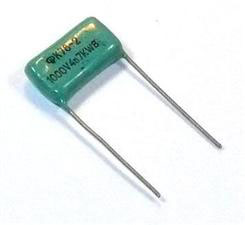
In the case when the capacitor is not marked with a rating, then the integer value indicates that the capacitance is indicated in picofarads, for example, 1000, and the value expressed as a decimal fraction indicates the rating in microfarads, for example 0.01.

The capacitance indicated on the case rarely corresponds to the actual parameter and deviates from the nominal value within a certain range. The exact value of capacitance that is aimed at in the manufacture of capacitors depends on the materials used for their production. The spread of parameters can range from thousandths to tens of percent.
The value of the permissible deviation of the capacitance is indicated on the capacitor case after the nominal value by putting down the letter of the Latin or Russian alphabet. For example, the Latin letter J (Russian letter I in the old designation) indicates a deviation range of 5% in one direction or another, and the letter M (Russian B) - 20%.

Such a parameter as the temperature coefficient of capacitance is rarely included in the marking and is applied mainly to small-sized elements used in electrical circuits of time-setting circuits. For identification, either an alphanumeric or color designation system is used.
There is also a combined letter-color marking. Its options are so diverse that in order to accurately determine the value of this parameter for each specific type of capacitor, an appeal to GOSTs or reference books on the corresponding radio components is required.
Rated voltage
The voltage at which the capacitor will operate during its specified service life while maintaining its characteristics is called the rated voltage. For capacitors of sufficient size, this parameter is applied directly to the element case, where the numbers indicate the nominal voltage value, and the letters indicate in which units it is expressed.
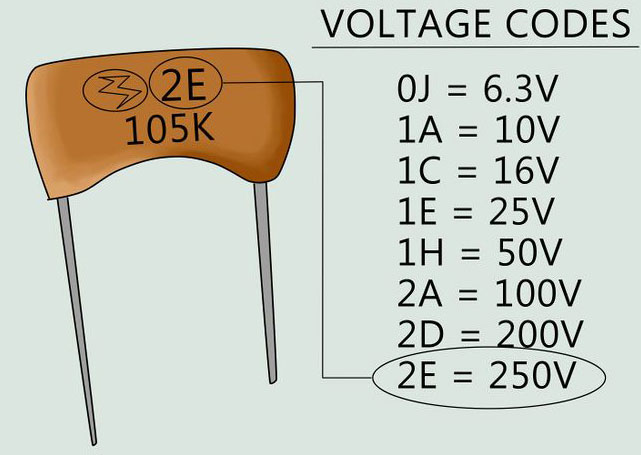
For example, the designation 160V or 160V indicates that the nominal voltage is 160 volts. Higher voltages are indicated in kilovolts - kV. On small capacitors, the nominal voltage value is encoded with one of the letters of the Latin alphabet. For example, the letter I corresponds to a nominal voltage of 1 volt, and the letter Q corresponds to 160 volts.
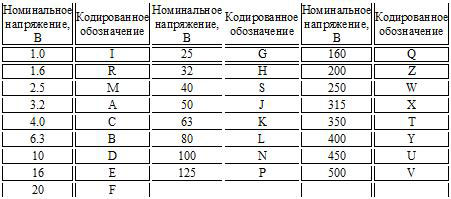
Release date
According to "GOST 30668-2000 Products of electronic equipment. Marking”, letters and numbers indicating the year and month of issue are indicated.
“4.2.4 When designating the year and month, first indicate the year of manufacture (the last two digits of the year), then the month with two digits. If the month is indicated by a single digit, then it is preceded by a zero. For example: 9509 (1995, September).
4.2.5 For products whose overall dimensions do not allow designating the year and month of manufacture in accordance with 4.2.4, the codes given in tables 1 and 2 should be used. The marking codes given in table 1 are repeated every 20 years.
The date when this or that production was carried out can be displayed not only in the form of numbers, but also in the form of letters. Each year has a correlation with a letter from the Latin alphabet. The months from January to September are numbered from one to nine. The month of October has a relationship with the number zero. November corresponds to the letter of the Latin type N, and December - D.
| Year | The code |
|---|---|
| 1990 | A |
| 1991 | B |
| 1992 | C |
| 1993 | D |
| 1994 | E |
| 1995 | F |
| 1996 | H |
| 1997 | I |
| 1998 | K |
| 1999 | L |
| 2000 | M |
| 2001 | N |
| 2002 | P |
| 2003 | R |
| 2004 | S |
| 2005 | T |
| 2006 | U |
| 2007 | V |
| 2008 | W |
| 2009 | X |
| 2010 | A |
| 2011 | B |
| 2012 | C |
| 2013 | D |
| 2014 | E |
| 2015 | F |
| 2016 | H |
| 2017 | I |
| 2018 | K |
| 2019 | L |
The location of the marking on the body
Labeling plays an important role on any product. Often it is applied to the first line on the body and has a capacity value. The same line assumes the placement of the so-called tolerance value on it. If both drawings do not fit on this line, then this can be done on the next one.
A similar system is used to apply film-type condensates. The location of the elements must be located according to a certain regulation, which is produced by GOST or TU for an element of an individual type.
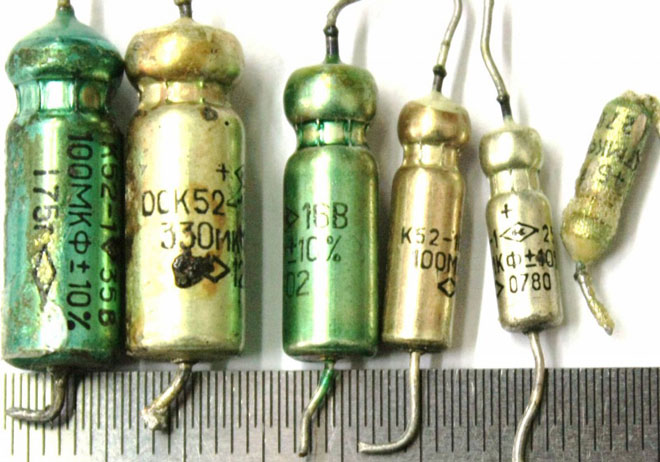
Color marking of domestic radioelements
With the production of lines with so-called automatic installation types, color application also appeared, as well as its direct significance in the entire system.
To date, the most used application using four colors. In this case, resorted to the use of four bands.So, the first strip, together with the second one, represents the capacitance value in the so-called picofarads. The third bar indicates the deviation that can be allowed. And the fourth band, in turn, means the voltage of the nominal type.
We give you an example of how this or that element is designated - capacity - 23 * 106 picofarads (24 F), permissible deviation from the nominal value - ± 5%, rated voltage - 57 V.

Marking of imported capacitors
To date, the standards that have been adopted from the IEC apply not only to foreign types of equipment, but also to domestic ones. This system involves the application of a code type marking on the body of the product, which consists of three direct digits.
The two numbers that are located from the very beginning indicate the capacity of the item and in units such as picofarads. The number that is third in order is the number of zeros. Consider this using the example of 555 - this is 5500000 picofarads. In the event that the capacitance of the product is less than one picofarad, then zero is indicated from the very beginning.

There is also a three-digit type of encoding. This type of application is applied exclusively to parts that are highly precise.
Color marking of imported capacitors
The designation of names on an object such as a capacitor has the same production principle as on resistors. The first stripes on the two rows indicate the capacity of this device in the same measuring units. The third strip has a designation on the number of direct zeros. But at the same time, the blue color is completely absent, blue is used instead.
It is important to know that if the colors are the same in a row, then it is advisable to make gaps between them so that it is clearly understandable. Indeed, in another case, these bands will merge into one.

Marking smd components
So-called SMD components are used for surface mounting and are extremely small in size. Accordingly, for this reason, they are marked with a minimum size. As a result, there is a system of abbreviation of both numbers and letters. The letter has the designation of the capacitance of a particular object in units of picofarads. As for the number, it denotes the so-called multiplier to the tenth power.
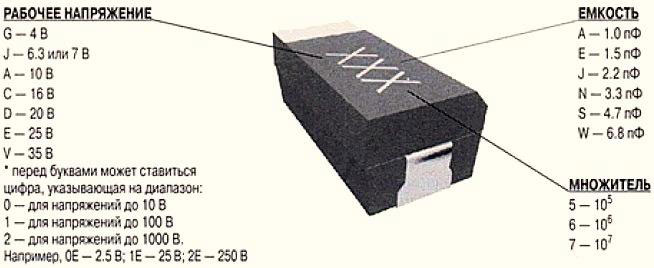

Very common electrolytic capacitors can have values of the main parameter type on their immediate body. This value has a fraction as a decimal type.
Conclusion
As you may have guessed, the labeling of these items has a very wide option. A particularly large number of markings have capacitors that were produced abroad. Quite often there are products of small size, parameters that can be determined using special measurements.
Similar articles:
